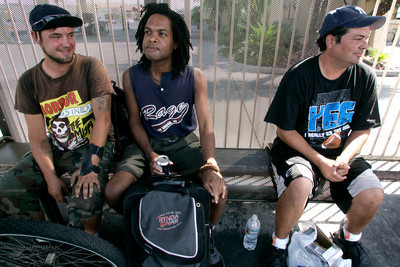Drivers, not bus shelters, kill

As vehicles sped by, Mike Gilmore admitted that he worried one would come up on the sidewalk and crash into the bus shelter where he was waiting.
“You always have to be watching,” the 40-year-old said.
Gilmore was waiting for the Citizen’s Area Transit bus 109 on Maryland Parkway.
Along with a number of other folks, he was waiting at the stop just north of Flamingo Road when I struck up a conversation with him.
At that moment, a pickup barreling north on Maryland honked at a man who had wandered into the street to bypass the crowded bus shelter, which took up too much of the sidewalk for him to pass.
Happens all the time, Gilmore said.
“We’re not even five feet away from the cars that come around the corner at 45 mph,” Gilmore said.
I measured by walking foot to foot from the bench where Gilmore sat inside the bus shelter to the asphalt on Maryland. My not-exactly-scientific measurement came in at 41/2 feet.
If a vehicle were to jump the curb, Gilmore said, “We’re over. We’re out. We’re done.”
Gilmore has been concerned about such a prospect, especially with the recent spate of bus stop crashes that have left one dead and several others injured.
On July 7, two women were struck at a bus stop on Boulder Highway near Flamingo.
One died. The other was seriously injured.
Last Sunday, a man was injured when a sedan crashed into a bus stop on Tropicana Avenue near Mojave Road.
Those crashes have garnered a lot of attention. The drivers in each situation are suspected of being drunk or drugged.
I was surprised to learn that there have been 13 injuries or deaths resulting from bus stop crashes in the past six years.
I certainly don’t mean to downplay that number, but compare it to the hundreds upon hundreds of people who have been killed or injured in motor vehicle crashes over the same period of time.
I was even more surprised to learn from Jacob Snow, general manager of the Regional Transportation Commission, which oversees public transit in the valley, of the one overriding common denominator in the crashes.
All but one were caused by an impaired driver, a driver suspected of impairment, or a driver not obeying traffic laws.
The other wreck was caused when a trailer became unhitched and crashed into a bus stop.
Snow said his team has looked for other similarities, including speed limits, the width of the road and the geographical location.
There was no link outside of drivers not obeying traffic laws, Snow said.
Still, making bus stops safer has been a much-discussed topic among commission members.
Although some solutions have been considered, including putting bollards — posts sometimes made of steel — in front of the shelters, Snow believes the best course of action is to move the bus shelters further back from the road and behind sidewalks.
That plan was aided last year when the Legislature passed a measure making bus shelters the equivalent of utilities, making it easier to move shelters onto private property or farther back onto public property.
Since then, 70 of the roughly 1,200 shelters in the valley have been moved back, Snow said.
Public entities have been more willing to allow the shelters moved onto their property, Snow added.
“When it comes to private property owners, we’ve had some limited success. Most people aren’t too excited to have something moved onto their private property,” he said.
Snow admitted that moving the bus stop farther from the curb won’t make a difference if a vehicle does collide with the shelter.
But it does minimize the exposure of folks waiting for the bus, Snow said.
Back on Maryland Parkway, Gilmore knows he’d feel a lot safer if the bus stop was at least 20 feet back.
He feels safest when there is a cutout in the road where a bus can pull in and away from the traffic.
Of course, there is an easy solution to the problem, Snow told me.
Drivers need to obey the rules of the road.
If you have a question, tip or tirade, call Francis McCabe at (702) 387-2904, or send an e-mail to roadwarrior@reviewjournal. com. Please include your phone number.